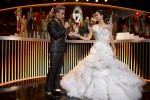Although they’ve left the arena, the games aren’t over.
After a year-and-a-half-long wait, the much-anticipated second installment of the “The Hunger Games” film franchise finally hits the big screen.
In this action-packed sequel, Katniss Everdeen (Jennifer Lawrence) and Peeta Mellark (Josh Hutcherson) face the repercussions of the risky stunt that bonded the two together at the end of their first Hunger Games. Amid the controversy of their act, as their attempts to lay low in the face of a full-on rebellion fails, they are called back to the arena for the Quarter Quell, the 75th anniversary of the Games.
This film has a lot going for it, including excellent performances by its star-studded cast. Lawrence delves into the character of Katniss, giving a convincing portrayal of someone dealing with post-traumatic stress. Her performance accentuates all the best parts of the much-loved heroine as she effortlessly brings fear, love and sass to the screen.
Opposite Lawrence, Hutcherson takes his character Peeta up a few pegs from the first film. In a delightfully understated way, Hutcherson embodies Peeta’s “nice guy” demeanor, but with an edge of rebellion just under the surface. His supporting performance is strong, and this time around, the chemistry between the two stars has a much more organic feel to it.
All around, the cast steps it up for this emotionally charged sequel. A number of extras give very compelling performances as they stage brutal uprisings and defiantly send salutes to Katniss and Peeta during their Victory Tour. These scenes are particularly hard to stomach, especially for empathetic moviegoers, as they depict the loss of innocent lives.
“Catching Fire” brings a lot to the table from a visual standpoint. The violence is more graphic, the costumes are more fantastical and the effects are even bigger than in the first film. The looks of Katniss and Peeta’s publicist Effie Trinket (Elizabeth Banks), for example, stun the eye with vivid colors and unconventional shapes.
In this case, shelling out the extra bucks for the IMAX experience is well worth it. Director Francis Lawrence transports the viewer directly into the arena and mimics the experience of the tributes.
The camera techniques used in this film are very effective at conveying the depth of the story. Tastefully shaky action sequence shots help build a sense of urgency and give the effect of complete chaos. The use of close-up face shots during personal or important dialogue scenes builds a strong intimacy between the viewer and the characters, and brings out the actors’ raw emotion onscreen.
Die-hard book loyalists will be glad to know that the film stays nearly true to the original plot. While there are minor adjustments, they are welcome changes, as they make the narrative more cohesive and give the film depth. Slower parts, such as Katniss’ beautification sequences and photo shoots, are gladly exchanged for more intriguing scenes depicting the scheming of Head Gamemaker Plutarch Heavensbee (Philip Seymour Hoffman).
Compared to its predecessor, “Catching Fire” is the superior film. This time around, everything is more raw and electric. Every scene is composed either to create a visual spectacle or to emotionally shock the viewer, so that by the end, it’s hard to walk away without feeling a little exhausted. However, the sensory overload is more than appreciated, as it ushers in a feeling of satisfaction.
The only slight deterrence in the film is its finale. Those who have read the book will fully know that the end of “Catching Fire” is less than desired, but the cliched approach to the film’s conclusion is what falls flat. Lawrence nearly saves it with a haunting look, but there still remains room for improvement.
“Catching Fire” is a must-see. It’s sure to keep nearly anyone entertained with its captivating performances and compelling story.
